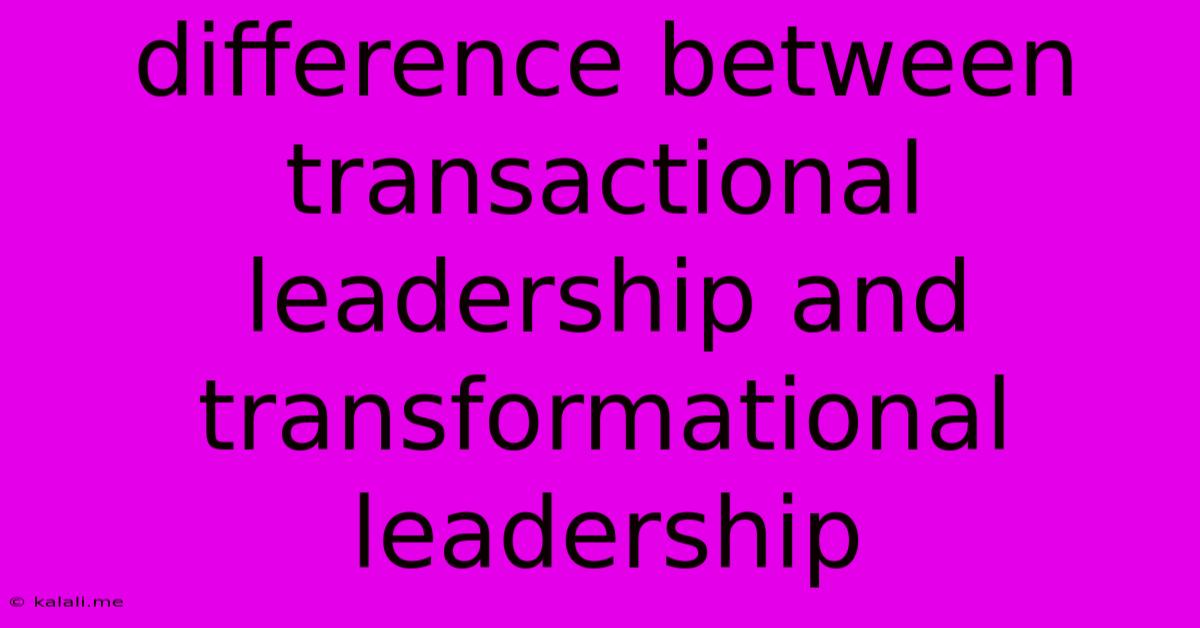Difference Between Transactional Leadership And Transformational Leadership
Kalali
Jun 15, 2025 · 3 min read

Table of Contents
Transactional vs. Transformational Leadership: Unveiling the Key Differences
Understanding the nuances between transactional and transformational leadership is crucial for effective management and organizational success. While both styles aim to achieve goals, their approaches and impact differ significantly. This article delves into the core distinctions, highlighting the strengths and weaknesses of each, and ultimately helping you determine which style best suits your leadership needs.
Meta Description: Discover the key differences between transactional and transformational leadership styles. Learn their strengths, weaknesses, and how to choose the right approach for optimal leadership.
What is Transactional Leadership?
Transactional leadership is a managerial approach based on a system of rewards and punishments. Leaders utilizing this style establish clear goals and expectations, offering rewards for meeting targets and implementing penalties for failure. It's a highly structured approach, relying on a clear hierarchy and well-defined roles. Think of it as a "transaction": completing tasks in exchange for rewards.
Key Characteristics of Transactional Leadership:
- Contingent Reward: Leaders clearly define expectations and offer rewards for achieving them. Performance is closely monitored and evaluated.
- Management by Exception (active): Leaders actively monitor performance, looking for deviations from standards and taking corrective action.
- Management by Exception (passive): Leaders intervene only when problems arise, focusing primarily on correcting errors rather than proactively preventing them.
- Laissez-faire: This is a hands-off approach where the leader provides minimal guidance or feedback, often leading to a lack of direction and motivation.
Strengths of Transactional Leadership:
- Clear Expectations: Employees understand what is expected of them, leading to increased clarity and productivity.
- Structured Environment: The hierarchical structure provides a sense of order and stability.
- Measurable Results: Progress can be easily tracked and evaluated based on predefined metrics.
- Efficiency: Suitable for routine tasks and situations requiring immediate action.
Weaknesses of Transactional Leadership:
- Limited Motivation: Reliance solely on rewards and punishments can stifle intrinsic motivation and creativity.
- Lack of Innovation: Emphasis on maintaining the status quo can hinder innovation and adaptation to change.
- Dependence on Authority: Employees may become overly reliant on the leader for direction, hindering independent thinking and problem-solving.
- Potential for Micromanagement: Constant monitoring and corrective action can lead to micromanagement and decreased employee morale.
What is Transformational Leadership?
Transformational leadership, in contrast, focuses on inspiring and motivating followers to achieve extraordinary outcomes. These leaders foster a shared vision, encourage creativity, and empower their team members. The focus is on building relationships, developing individual potential, and creating a culture of continuous improvement.
Key Characteristics of Transformational Leadership:
- Charisma: Leaders inspire and motivate followers through their personality and vision.
- Inspirational Motivation: Leaders articulate a clear vision and inspire followers to strive for ambitious goals.
- Intellectual Stimulation: Leaders encourage creativity, innovation, and problem-solving.
- Individualized Consideration: Leaders provide support, mentoring, and coaching to each team member.
Strengths of Transformational Leadership:
- Increased Motivation and Engagement: Employees feel valued and empowered, leading to higher levels of motivation and engagement.
- Enhanced Creativity and Innovation: The emphasis on intellectual stimulation fosters a culture of innovation and adaptation.
- Stronger Organizational Culture: A shared vision and strong leader-follower relationships create a positive and supportive work environment.
- Improved Organizational Performance: Higher levels of motivation and innovation often translate to improved organizational performance.
Weaknesses of Transformational Leadership:
- Potential for Charisma Abuse: Overly charismatic leaders may prioritize their own needs over the needs of the team.
- Difficult to Scale: This leadership style can be challenging to implement in large organizations.
- Time-Consuming: Building strong relationships and providing individualized attention requires significant time and effort.
- Dependence on Leader: The team's success may become overly dependent on the leader's charisma and vision.
Choosing the Right Approach:
The most effective leadership style often involves a blend of transactional and transformational approaches. Transactional leadership can be highly effective for managing routine tasks and ensuring accountability, while transformational leadership is crucial for driving innovation, inspiring teams, and achieving ambitious goals. The optimal approach depends on the specific context, organizational culture, and the nature of the tasks at hand. Understanding the strengths and weaknesses of each allows for a more adaptable and effective leadership strategy.
Latest Posts
Latest Posts
-
How To Find The Radius Of A Triangle
Jun 15, 2025
-
The Speed Of An Object In A Particular Direction
Jun 15, 2025
-
Oxidation Number Of Cr In K2cr2o7
Jun 15, 2025
-
Anything That Occupies Space And Has Mass Is Called
Jun 15, 2025
-
Line M Is Parallel To Line N
Jun 15, 2025
Related Post
Thank you for visiting our website which covers about Difference Between Transactional Leadership And Transformational Leadership . We hope the information provided has been useful to you. Feel free to contact us if you have any questions or need further assistance. See you next time and don't miss to bookmark.